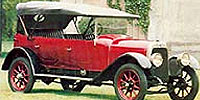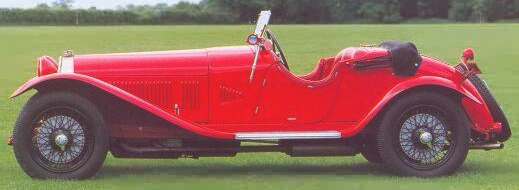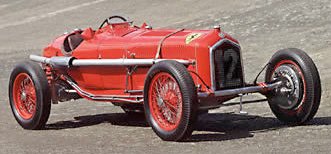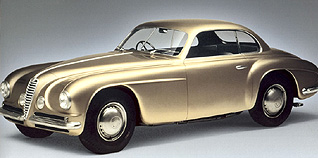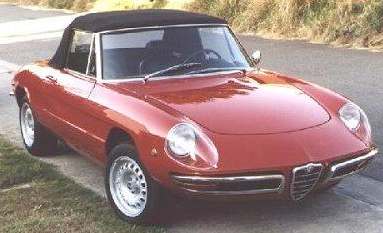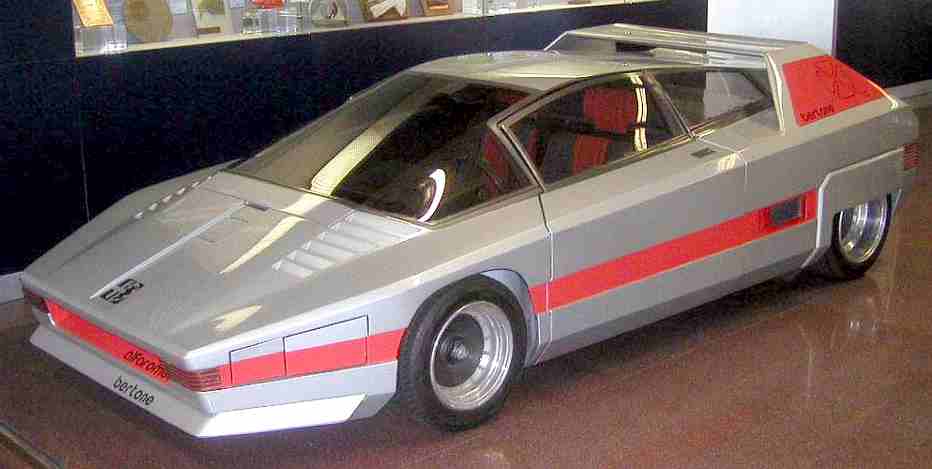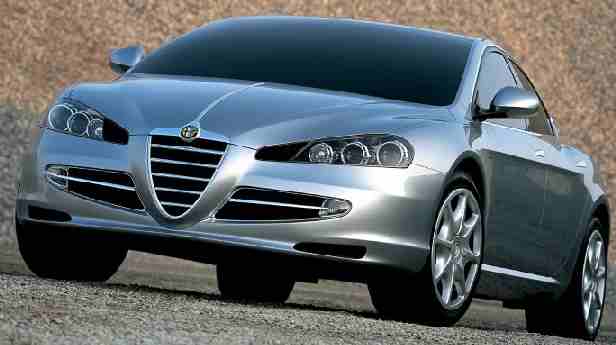|
||||
|
Alfa Romeo is an Italian automobile manufacturing company, founded as "Darracq Italiana" by Cavaliere Ugo Stella, an aristocrat from Milan in partnership with the French automobile firm of Alexandre Darracq. The partnership refurbished an idle Darracq factory in Portello, a Milan suburb, but at the onset of World War I the company converted to a munitions factory and the partnership was dissolved. It has been a part of Fiat SpA since 1987. Fiat plans to put Alfa Romeo together with another division, Maserati, to create a sports/luxury car division within the Fiat Group. The company was originally known as ALFA, which is an acronym meaning Anonima Lombarda Fabbrica Automobili.
The first production A.L.F.A. designed by Merosi was the 1910 24HP. This large, conventional touring car and subsequent designs by Merosi were solid and unadventurous, but consistently achieved a high level of quality and reliability. A.L.F.A.'s sales grew, but the outbreak of WWI put a stop to automobile production.
The first car desgned by the new Alfa Romeo was the G1 in 1920, a large touring car. With some engine modifications this became the G2 in 1921. In 1922 the RL series cars, with 3000 six cylinder push-rod OHV engines, were introduced, including the RLN (21/70hp) 'Normale', the RLT (22/70hp) 'Turismo', RLS and RLSS (22/90hp).They were followed the following year by the RM series models, a smaller version with 2000 four cylinder engines and RM, RMS 'Sport' and RMU 'Unificato' versions (15/50hp an 15/55hp). In all the above cars, the first number is the approximate horsepower, the second the approximate top speed. These cars were the last designed by Merosi.
In 1915 Nicola Romeo bought ALFA after which his surname was appended to the ALFA initials . 1916 the company came under the complete control the high-flying Neopolitan mathematician and industrialist.
Within a few years of Nicola Romeo taking control, the company began to participate in Grand Prix motor racing. Guiseppe Merosi, a self-taught engineer, was hired as head designer.
In 1923 Jano began working for Alfa Romeo, and his first design was the successful formula 1 car, the P2. Production cars soon followed, in 1927 began the production of the 6C 1500, designating a six cylinder 1500cc engine. Originally this was a sohc producing 44bhp, but dohc versions soon took over. These were both normally aspirated and supercharged, producing around 54 and 76 bhp respectively. In 1929 bigger 1750 versions were introduced, both in sohc (45bhp) and dohc (55bhp) form. Again a supercharged version was also available, producing 85bhp.
During the crisis of 1929 Romeo's industrial empire had financial difficulties and suffered serious damage. Romeo had been removed as director in 1928 and the company passed into government receivership shortly after the crash.
Alfa Romeo scored many prestigious victories in all the different categories: Formula 1, Prototypes, Touring and Fast Touring. Private drivers also run some rally competitions with fine results.
In the 1930s, Tazio Nuvolari won the Mille Miglia in a 6C 1750 http://members.tripod.lycos.nl/AlfaTom2/galleria1/24hp.htm crossing the finishing line after having incredibly overtaken Achille Varzi without his lights (at nighttime).
The 8C 2300 won the Le Mans 24 Hours from 1931 to 1934. In 1935 Alfa Romeo won the German Grand Prix with Nuvolari. The story goes that Henry Ford used to doff his hat when he saw an Alfa Romeo pass, and that on the day he managed to beat the Alfas, Enzo Ferrari cried like a baby.
In 1934 it was absorbed with other industrial companies by an agency of the Facist government, the Instituto di Riconstruzzione Industriale (IRI), which controlled it for over 50 years. The second World War again brought a virtual halt to car production at Alfa.
Partially-assembled production vehicles were put in storage and a few racing and experimental cars were hidden in caves north of Milan. The war was a disaster for Italy and for Alfa. Occupying German troops commandeered part of what remained of the severely damaged factory. The design team worked through the destruction to develop a different kind of Alfa Romeo for the changed Europe that lay ahead.
In 1954 appeared the first Giulietta, again designed by Satta. First available was the Giulietta Sprint with a 1290cc dohc engine, the Berlina (four door saloon) and Spider (cabriolet) appearing in the following year. The 1900 continued to be produced, and was revised to become the 2000 with a bored out engine and an extra 10bhp. The 2000 was available as a Berlina and a Spider. The 2600 was introduced in 1962 in Berlina, Spider and Sprint variants as the 'large' Alfa Romeo, and was actually the first production Alfa to use brake discs.
A completely new passenger car, the Alfa Romeo 1900, was introduced in 1950 and in 1954 the Giulietta was introduced. The Giulietta is essentially the beginning of the modern era in Alfa Romeo's history.
Alfa Romeo Super Sport 1949
Before being bought by Fiat, Alfa Romeo always had a daring commercial policy, constantly experimenting with new solutions and using them in its series production, even at the risk of losing market share. On an English sales brochure:
It represented the make of those cars which could allow some sport driving on common roads, provided the driver was clever enough to let them express their particular "sound".
In 1950 Nino Farina won the Formula One World Championship in a 158 with compressor, in 1951 Juan Manuel Fangio won while driving a Alfetta 159 (an evolution of the 158 with a two-stages compressor). In the 1960s Alfa Romeo was bought by the Italian government and became famous for its models specifically designed for Italian police
Alfa Romeo Spyder
n 1967 the famous Dustin Hoffman's film "The Graduate" gave worldwide unforgettable celebrity to the "Spider" (best known with the Italian nickname of "Duetto", or as "Osso di Seppia" or Round-tail), and its unique shape. After the 1970s, a economic issues caused the government to sell Alfa Romeo to Fiat, which still owns it.
1972
was a year of revolutionary change for Alfa Romeo with the introduction of
the Alfasud,
the first front-wheel drive Alfa, designed by Rodolfo Hruska and using a
1200 four cylinder horizontally opposed engine. In the same year the Alfetta
was introduced, the most significant technical change being the move to a
de Dion rear suspension and rear mounted transaxle containing clutch,
gearbox and differential. This was joined in 1974 by the Alfetta
GT, a coupe design by Giugiaro.
Alfa Romeo 'Navjo' (Bertone) 1976
In 1976 the first diesel powered Alfa was introduced, the Giulia diesel. The Giulietta name was revived in 1977 for an Alfetta based car with 1300 and 1600 engines. The Alfetta continued with the 2000. A new top-of-the-range Alfa was introduced in 1979 in the shape of the Alfa 6. This used an all new 2492cc V6 engine producing 160bhp and a similar suspension layout to the Alfetta. A coupe version, the GTV6 was also introduced.
Until the 1980s, Alfa Romeos, except for the Alfasud, were rear-wheel-drive. In 1995 Alfa Romeo ceased exporting cars to the US. While rumours occasionally surface of their intent to return to that market, no formal plans have ever been announced. The most credible is a rumour that, with Maserati's help, the Alfa Romeo 159 and Alfa Romeo Brera will be the make's pilot models should it reenter the North American market. Cloverleaf are variants of Alfa Romeo cars, where the name denotes the high-end of the range in comfort and engine size, but previously denoted Alfa Romeo racing cars in the pre-second-world-war era. The image first appeared in 1923 when Ugo Sivocci presented one prior to the start of the 14th Targa Florio as a good luck token to the team. Some modern Alfas wear a cloverleaf badge which is typically a green four leaf clover on a white background, but variants of blue on white have been recently
Alfa Romeo Visconti 2004 (Giugiaro)
The Alfa Romeo Visconti is built on the new Alfa Romeo Premium Platform that will also carry the replacement for the Alfa Romeo 156 and the production version of the Alfa Romeo Brera that stunned the world 18 months ago. It was designed by Giorgetto Giugiaro and revealed at the Geneva International Motor Show. Under the bonnet is the first sighting of a new Alfa Romeo V6 engine, a twin turbo 3.2 litre V6 with the lean burn JTS heads used in the 2.0 litre engine in the present 156. This is not a derivative of the 3.2 litre GTA engine, but the first of an all new family of V6 power units that will up to more than 400 bhp and 680 Nm of torque.
|
||||
|
The
content of this website is copyright © and design copyright 1991 and
2006 Electrick Publications and NJK. All rights reserved. The bird |
||||
 ALFA
ROMEO HISTORY
ALFA
ROMEO HISTORY
